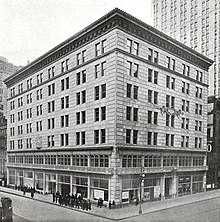
Otto Koloman Wagner was an Austrian architect, furniture designer and urban planner. He was a leading member of the Vienna Secession movement of architecture, founded in 1897, and the broader Art Nouveau movement. Many of his works are found in his native city of Vienna, and illustrate the rapid evolution of architecture during the period. His early works were inspired by classical architecture. By mid-1890s, he had already designed several buildings in what became known as the Vienna Secession style. Beginning in 1898, with his designs of Vienna Metro stations, his style became floral and Art Nouveau, with decoration by Koloman Moser. His later works, 1906 until his death in 1918, had geometric forms and minimal ornament, clearly expressing their function. They are considered predecessors to modern architecture.

George Browne Post, professionally known as George B. Post, was an American architect trained in the Beaux-Arts tradition. Active from 1869 almost until his death, he was recognized as a master of several prominent contemporary American architectural genres, and instrumental in the birth of the skyscraper.

Congregation Emanu-El of New York is the first Reform Jewish congregation in New York City. It has served as a flagship congregation in the Reform branch of Judaism since its founding in 1845. The congregation uses Temple Emanu-El of New York, one of the largest synagogues in the world.

The Vienna Secession is an art movement, closely related to Art Nouveau, that was formed in 1897 by a group of Austrian painters, graphic artists, sculptors and architects, including Josef Hoffman, Koloman Moser, Otto Wagner and Gustav Klimt. They resigned from the Association of Austrian Artists in protest against its support for more traditional artistic styles. Their most influential architectural work was the Secession exhibitions hall designed by Joseph Maria Olbrich as a venue for expositions of the group. Their official magazine was called Ver Sacrum, which published highly stylised and influential works of graphic art. In 1905 the group itself split, when some of the most prominent members, including Klimt, Wagner, and Hoffmann, resigned in a dispute over priorities, but it continued to function, and still functions today, from its headquarters in the Secession Building. In its current form, the Secession exhibition gallery is independently led and managed by artists.
Broadway United Church of Christ is a Congregationalist Church located on West 71st Street, between Amsterdam Avenue and Columbus Avenue on the Upper West Side of Manhattan.

Leopold Eidlitz was an American architect best known for his work on the New York State Capitol, as well as "Iranistan" (1848), P. T. Barnum's house in Bridgeport, Connecticut; St. Peter's Church, on Westchester Avenue at St. Peter's Avenue in the Bronx (1853); the Brooklyn Academy of Music on Montague Street in Brooklyn ; the former Temple Emanu-El ; the Broadway Tabernacle ; the completion of the Tweed Courthouse (1876–81); and the Park Presbyterian Chapel on West 86th Street and Amsterdam Avenue.
Cyrus Lazelle Warner Eidlitz was an American architect best known for designing One Times Square, the former New York Times Building on Times Square. He is founder of the architecture firm presently known as HLW International, one of the oldest architecture firms in the United States.

Clinton and Russell was a well-known architectural firm founded in 1894 in New York City, United States. The firm was responsible for several New York City buildings, including some in Lower Manhattan.
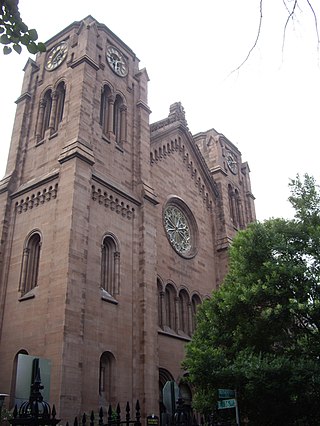
St. George's Episcopal Church is a historic church located at 209 East 16th Street at Rutherford Place, on Stuyvesant Square in Manhattan, New York City. Called "one of the first and most significant examples of Early Romanesque Revival church architecture in America", the church exterior was designed by Charles Otto Blesch and the interior by Leopold Eidlitz. It is one of the two sanctuaries of the Calvary-St. George's Parish.

Carl Pfeiffer (1834-1888) was a German American architect practicing in New York City.

Iranistan was a Moorish Revival mansion in Bridgeport, Connecticut commissioned by P. T. Barnum in 1848. It was designed by Bohemian-American architect Leopold Eidlitz. At this "beautiful country seat" Barnum played host to such famous contemporaries as the Hutchinson Family Singers, Matthew Arnold, George Armstrong Custer, Horace Greeley, and Mark Twain. The grandiose structure survived only a decade before being destroyed by fire in 1857. It was one of five such fires in the showman's life that "burned to the ground all his accomplishments".
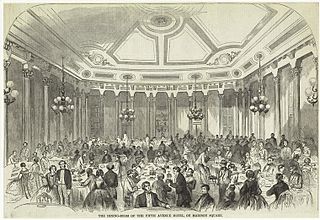
Griffith Thomas (1820—1879) was an American architect. He partnered with his father, Thomas Thomas, at the architecture firm of T. Thomas and Son.

HLW is a full-service design firm headquartered in New York City, with offices in Madison, New Jersey; Stamford, Connecticut; Los Angeles and San Francisco, California; West Palm Beach, Florida; and London. HLW is one of the oldest continuously operating design firms in the United States.
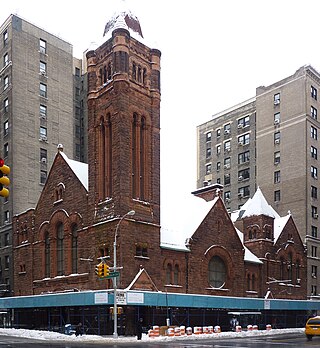
West-Park Presbyterian Church is a Romanesque Revival Presbyterian church located on the corner of Amsterdam Avenue at 86th Street on the Upper West Side of Manhattan in New York City. It consists of a main sanctuary and chapel.

Henry Franklin Kilburn, FAIA, was an American architect active in late-nineteenth- and early-twentieth-century New York City who is particularly associated with church architecture. Although he practiced for a number of years, only toward the end of his career, however, was Kilburn primarily active with ecclesiastical commissions; the New York City Landmarks Preservation Commission reports that "Kilburn was also the architect of many private residences, factories, stables, and theaters in Manhattan."

The Germania Bank Building is a historic building at 190 Bowery, on the northwest corner of the intersection with Spring Street in Manhattan, New York City. It was the third building of the Germania Bank, which was founded in New York City in 1869. The building was designed in a Renaissance Revival or Beaux Arts style by Robert Maynicke and was built in 1898–99. The building became a New York City designated landmark on March 29, 2005. As of 2022, the building contains EmpireDAO, a coworking space for cryptocurrency and blockchain ventures.

Cyrus Lazelle Warner (1789–1852) was an American architect in New York City. He designed the Greek Revival architecture Kahal Kadosh Beth Elohim Synagogue, built in 1840 in Charleston, South Carolina, as well as a church in a similar style two years earlier. He was also involved in the Merchant's Exchange Building with Isaiah Rogers. He had his office at 122 Broadway from 1842 until 1847.

Andrew J. Robinson was a builder in New York City and partner in the firm Robinson & Wallace established in 1872 and later reorganized as the Andrew J. Robinson Company. His firms built St. Luke's Hospital (1895), the St. Paul Building (1897), New York Hospital, the Havemeyer Hall (1898), the East River Savings Bank, Blair Building, B.F. Goodrich Company Building at 1780 Broadway (1909) and Pabst Hotel (1902). Real Estate Record and Builders' Guide referred to him as one of New York's most prominent builders for more than 50 years in his 1922 obituary.
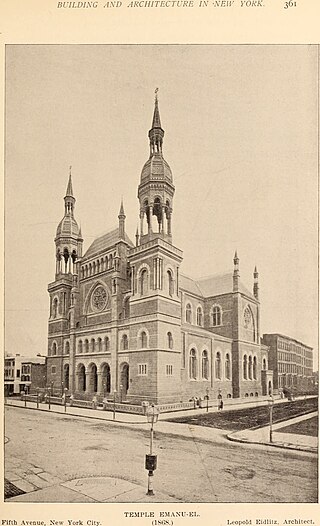
Temple Emanu-El was a large Reform Jewish synagogue located on Fifth Avenue and 43rd Street in Midtown Manhattan, New York City, New York, United States. Built in 1868, it was demolished in 1927.

The Greenwich Savings Bank Building, also known as the Haier Building and 1356 Broadway, is an office building at 1352–1362 Broadway in the Midtown Manhattan neighborhood of New York City. Constructed as the headquarters of the Greenwich Savings Bank from 1922 to 1924, it occupies a trapezoidal parcel bounded by 36th Street to the south, Sixth Avenue to the east, and Broadway to the west. The Greenwich Savings Bank Building was designed in the Classical Revival style by York and Sawyer.


